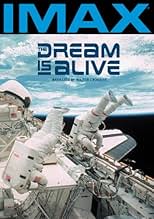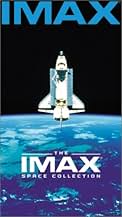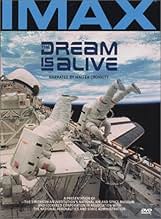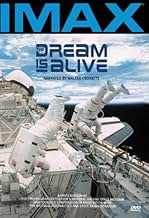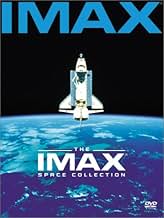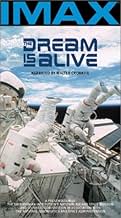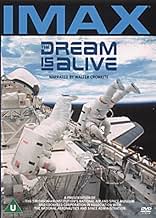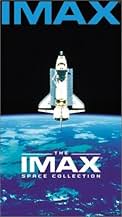Traveling on the Space Shuttle, covers training, launch, flight, deployment of LDEF from Challenger in April 1984 (STS-41C).Traveling on the Space Shuttle, covers training, launch, flight, deployment of LDEF from Challenger in April 1984 (STS-41C).Traveling on the Space Shuttle, covers training, launch, flight, deployment of LDEF from Challenger in April 1984 (STS-41C).
- Director
- Writer
- All cast & crew
- Production, box office & more at IMDbPro
Featured reviews
To date, NASA has made five IMAX films that have been shot from the Space Shuttle or the Space Station. "The Dream is Alive" was the first, and is probably still the best. It must be seen on the IMAX screen to fully appreciate it, but still looks and sounds good on DVD if seen on a big television with a good sound system. The launch sequences would be excellent opportunities for audiophiles to display their subwoofers to admiring guests.
Considering that all of the film shot in space was shot by the shuttle crews rather than by professional cameramen, the results are outstanding. This is probably the closest you can get to the sensation of being in space, short of actually going there yourself. There are also excellent ground sequences of the shuttles being assembled, launched, and recovered, along with the training required for astronaut candidates all well chosen to look dramatic in the IMAX format.
The three shuttle missions featured in this film all took place during 1984, and the film was released in the summer of 1985. At the time it was released, NASA was launching shuttle missions at a rate never seen before or since. The film displayed the optimism of the time, where the safety of the flights was not in question, and the goal of everyone flying in space someday seemed to be within reach. NASA had a teacher-in-space program and a journalist-in-space program (as well as an unofficial politician-in-space program, where a congressman and a senator conned their way into space flights), and an ambitious program of fifteen launches was scheduled for 1986. Everything looked rosy, and the film reflects this.
Then, on the first (and only) shuttle launch of 1986, Challenger exploded, killing the crew of seven (including two of this film's cast). The previous optimism vanished, never to fully return, in the light of revelations about unresolved safety issues, unrealistic expectations, etc. The film is thus an artifact of this vanished era, and it's rather sad to see this atmosphere of optimism in the light of what was to follow. Nonetheless, the sequences in the movie are still very effective, and the subsequent IMAX space films have only managed to equal (but not exceed) what is seen here. If you're a space enthusiast, you owe it to yourself to see this at least once in an IMAX theater.
Considering that all of the film shot in space was shot by the shuttle crews rather than by professional cameramen, the results are outstanding. This is probably the closest you can get to the sensation of being in space, short of actually going there yourself. There are also excellent ground sequences of the shuttles being assembled, launched, and recovered, along with the training required for astronaut candidates all well chosen to look dramatic in the IMAX format.
The three shuttle missions featured in this film all took place during 1984, and the film was released in the summer of 1985. At the time it was released, NASA was launching shuttle missions at a rate never seen before or since. The film displayed the optimism of the time, where the safety of the flights was not in question, and the goal of everyone flying in space someday seemed to be within reach. NASA had a teacher-in-space program and a journalist-in-space program (as well as an unofficial politician-in-space program, where a congressman and a senator conned their way into space flights), and an ambitious program of fifteen launches was scheduled for 1986. Everything looked rosy, and the film reflects this.
Then, on the first (and only) shuttle launch of 1986, Challenger exploded, killing the crew of seven (including two of this film's cast). The previous optimism vanished, never to fully return, in the light of revelations about unresolved safety issues, unrealistic expectations, etc. The film is thus an artifact of this vanished era, and it's rather sad to see this atmosphere of optimism in the light of what was to follow. Nonetheless, the sequences in the movie are still very effective, and the subsequent IMAX space films have only managed to equal (but not exceed) what is seen here. If you're a space enthusiast, you owe it to yourself to see this at least once in an IMAX theater.
This is a great film. Beautiful and informative, it takes you out to orbit the earth. Some of the info is pretty basic, however, the shots of the earth and of space is gorgeous and inspiring. There is a haunting twist to it though, some of the crew on this mission later died in the Challenger accident.
I have had the EXTREME PLEASURE of seeing this SPECTACULAR movie 5 TIMES!!! I would have enjoyed seeing it MANY, MANY MORE TIMES ALSO!!! This is a movie, where after seeing it, you do not come out appreciating what the Astronauts do, I think that you do not appreciate the BEAUTY of SPACE! If I were 5'4", I would have been doing everything that I could so I could get my B. Science degree at a College or University so I could qualify to be on the Waiting List of Potential Astronauts! But, as my luck would have it, I am only 5'1/2", and so, unfortunately, this will have to be in another life... Ah, but the opportunity to see a Sunrise EVERY 90 MINUTES!!!! THAT WOULD BE THE ABSOLUTE BEST THING!!!!!!!!!!!!!!!!!!! IT WOULD BE SIMPLY GORGEOUS!!!
Space exploration has often returned to Earth incredible images not just from the heavens but of the Earth itself. So the pairing of out of this world images with IMAX seems like an ideal match and indeed space themed documentaries have long been a staple of IMAX's output. First premiering in 1985, The Dream Is Alive presents highlights from a year of NASA Space Shuttle missions and does so with IMAX's usual flair.
Having being made at the height of the Space Shuttle program in 1984, The Dream Is Alive is in some respects an interesting historical document for those interested in the history of space exploration. There's interesting behind the scenes footage of the shuttle program including the replacing of the shuttle's all important heat tiles (which would play a role in the tragic demise of the Columbia nearly two decades later) and the escape system astronauts would have (but thankfully never) used in the event of an emergency on the launch pad. There's also of course footage from a number of shuttle missions including footage of the now late Sally Ride as well as a number of including the dramatic recovery of the Solar Max satellite.
What this really captures more than anything else is the pre-Challenger atmosphere that surrounded the shuttle program including its early successes and the optimism that surrounded it. The tragedy of Challenger and the eventual disappointments of the shuttle program had yet to happen. There's something rather both odd and touching about the narration of Walter Cronkite, himself a major proponent and enthusiast of space exploration, at the end talking about how people would soon be living in space and how children would one day be born there. Close to thirty years later with the shuttle program over, the ISS soaring over our heads and the recent disasters of both NASA and Virgin space vehicles, the dream is alive but it seems as far away as ever.
Of course being IMAX, the visuals are all important. Filmed over the course of a number of different shuttle missions, The Dream Is Alive presents some incredible footage from those missions. There's dramatic sequences of the aforementioned satellite releases and captures ranging from Solar Max to the Long Duration Exposure Facility (LDEF) satellite. There's also some incredible point of view footage such as the opening sequence which gives the viewer the impression of what it's like to be inside the shuttle as it's landing and the aforementioned launch pad escape system. Perhaps the most dramatic footage though is of the Earth itself seen from space, bringing to mind the later IMAX space documentary Blue Planet.
Overall then, The Dream Is Alive remains a memorable addition to the IMAX space documentaries. While it has of course dated in its optimistic hopes for the shuttle program, it nevertheless presents a stirring picture of the shuttle program at its height. Thanks to the IMAX footage, it also remains a visual feast as well even on the small screen. For those interested or fascinated by space exploration, this is a must-see.
Having being made at the height of the Space Shuttle program in 1984, The Dream Is Alive is in some respects an interesting historical document for those interested in the history of space exploration. There's interesting behind the scenes footage of the shuttle program including the replacing of the shuttle's all important heat tiles (which would play a role in the tragic demise of the Columbia nearly two decades later) and the escape system astronauts would have (but thankfully never) used in the event of an emergency on the launch pad. There's also of course footage from a number of shuttle missions including footage of the now late Sally Ride as well as a number of including the dramatic recovery of the Solar Max satellite.
What this really captures more than anything else is the pre-Challenger atmosphere that surrounded the shuttle program including its early successes and the optimism that surrounded it. The tragedy of Challenger and the eventual disappointments of the shuttle program had yet to happen. There's something rather both odd and touching about the narration of Walter Cronkite, himself a major proponent and enthusiast of space exploration, at the end talking about how people would soon be living in space and how children would one day be born there. Close to thirty years later with the shuttle program over, the ISS soaring over our heads and the recent disasters of both NASA and Virgin space vehicles, the dream is alive but it seems as far away as ever.
Of course being IMAX, the visuals are all important. Filmed over the course of a number of different shuttle missions, The Dream Is Alive presents some incredible footage from those missions. There's dramatic sequences of the aforementioned satellite releases and captures ranging from Solar Max to the Long Duration Exposure Facility (LDEF) satellite. There's also some incredible point of view footage such as the opening sequence which gives the viewer the impression of what it's like to be inside the shuttle as it's landing and the aforementioned launch pad escape system. Perhaps the most dramatic footage though is of the Earth itself seen from space, bringing to mind the later IMAX space documentary Blue Planet.
Overall then, The Dream Is Alive remains a memorable addition to the IMAX space documentaries. While it has of course dated in its optimistic hopes for the shuttle program, it nevertheless presents a stirring picture of the shuttle program at its height. Thanks to the IMAX footage, it also remains a visual feast as well even on the small screen. For those interested or fascinated by space exploration, this is a must-see.
Released a year before the Challenger disaster changed NASA forever, The Dream is Alive tells the story about the space shuttle program, which started in 1981 with the launch of Columbia, and ends with the launch of Challenger. The cinematography and audio were ahead of its time.
Did you know
- ConnectionsReferenced in Premiere Video Perseveres (2011)
Details
Box office
- Gross worldwide
- $1,044,068
Contribute to this page
Suggest an edit or add missing content

